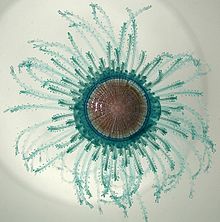Chondrophore
The chondrophores or porpitids are a small and unusual group of hydrozoans. They are the family Porpitidae.[1]
| Chondrophores | |
|---|---|

| |
| Blue button (Porpita porpita) | |
| Scientific classification | |
| Domain: | Eukaryota |
| Kingdom: | Animalia |
| Phylum: | Cnidaria |
| Class: | Hydrozoa |
| Order: | Anthoathecata |
| Suborder: | Capitata |
| Family: | Porpitidae Goldfuss, 1818 |
| Type genus | |
| Porpita | |
| Genera | |
| Synonyms | |
| |
They all live at the surface of the open ocean, and are colonies of carnivorous, free-floating hydroids. Their life-style in the plankton is similar to that of pelagic jellyfish.
The chondrophores look like a single organism but are cooperatives of polyps.
The most familiar members of the family Porpitidae are the blue button (Porpita porpita) and the by-the-wind sailor (Velella velella).
Structure
changeChondrophores may look like a jellyfish, but they really are not. Like the siphonophores they are not a single animal. They are a colony of clones, genetically identical zooids. These zooids are small, highly modified individual polyps. Though structurally similar to other cnidarians, the zooids do not live by themselves: they are attached to each other. Each type of zooid depends for survival on the others doing what it cannot do by itself.
This kind of set-up is also found in the siphonophores: the Portuguese man o' war. They evolved independently, and are classified in different orders.
Fossil record
changeA rare soft-bodied fossil was got from Mississippian strata in northeastern Kentucky. It was interpreted as a chondrophorine float.[2] The origin of the group was probably in the Neoproterozoic era, some 650–540 million years ago.
References
change- ↑ Schuchert, Peter 2012. The hydrozoa directory. Muséum Geneve
- ↑ Yochelson, Ellis L. and Mason, Charles E. 1986. A chondrophorine coelenterate from the Borden Formation (Lower Mississippian) of Kentucky, Journal of Paleontology. 60, 5, 1025-1028. [1]